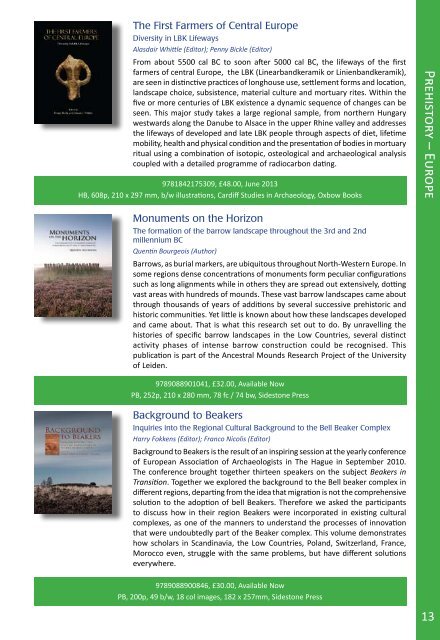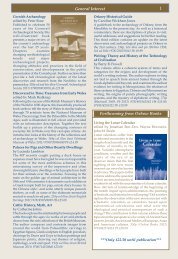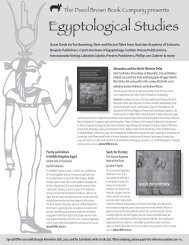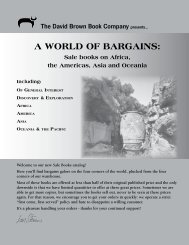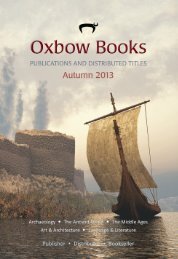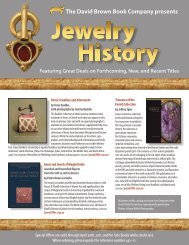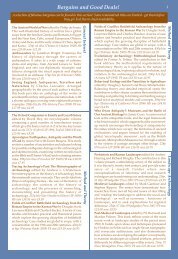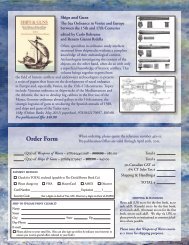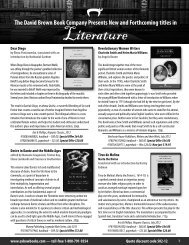Oxbow Spring 2013.pdf - Oxbow Books
Oxbow Spring 2013.pdf - Oxbow Books
Oxbow Spring 2013.pdf - Oxbow Books
You also want an ePaper? Increase the reach of your titles
YUMPU automatically turns print PDFs into web optimized ePapers that Google loves.
The First Farmers of Central Europe<br />
Diversity in LBK Lifeways<br />
Alasdair Whittle (Editor); Penny Bickle (Editor)<br />
From about 5500 cal BC to soon after 5000 cal BC, the lifeways of the first<br />
farmers of central Europe, the LBK (Linearbandkeramik or Linienbandkeramik),<br />
are seen in distinctive practices of longhouse use, settlement forms and location,<br />
landscape choice, subsistence, material culture and mortuary rites. Within the<br />
five or more centuries of LBK existence a dynamic sequence of changes can be<br />
seen. This major study takes a large regional sample, from northern Hungary<br />
westwards along the Danube to Alsace in the upper Rhine valley and addresses<br />
the lifeways of developed and late LBK people through aspects of diet, lifetime<br />
mobility, health and physical condition and the presentation of bodies in mortuary<br />
ritual using a combination of isotopic, osteological and archaeological analysis<br />
coupled with a detailed programme of radiocarbon dating.<br />
9781842175309, £48.00, June 2013<br />
HB, 608p, 210 x 297 mm, b/w illustrations, Cardiff Studies in Archaeology, <strong>Oxbow</strong> <strong>Books</strong><br />
Prehistory – Europe<br />
Monuments on the Horizon<br />
The formation of the barrow landscape throughout the 3rd and 2nd<br />
millennium BC<br />
Quentin Bourgeois (Author)<br />
Barrows, as burial markers, are ubiquitous throughout North-Western Europe. In<br />
some regions dense concentrations of monuments form peculiar configurations<br />
such as long alignments while in others they are spread out extensively, dotting<br />
vast areas with hundreds of mounds. These vast barrow landscapes came about<br />
through thousands of years of additions by several successive prehistoric and<br />
historic communities. Yet little is known about how these landscapes developed<br />
and came about. That is what this research set out to do. By unravelling the<br />
histories of specific barrow landscapes in the Low Countries, several distinct<br />
activity phases of intense barrow construction could be recognised. This<br />
publication is part of the Ancestral Mounds Research Project of the University<br />
of Leiden.<br />
9789088901041, £32.00, Available Now<br />
PB, 252p, 210 x 280 mm, 78 fc / 74 bw, Sidestone Press<br />
Background to Beakers<br />
Inquiries into the Regional Cultural Background to the Bell Beaker Complex<br />
Harry Fokkens (Editor); Franco Nicolis (Editor)<br />
Background to Beakers is the result of an inspiring session at the yearly conference<br />
of European Association of Archaeologists in The Hague in September 2010.<br />
The conference brought together thirteen speakers on the subject Beakers in<br />
Transition. Together we explored the background to the Bell beaker complex in<br />
different regions, departing from the idea that migration is not the comprehensive<br />
solution to the adoption of bell Beakers. Therefore we asked the participants<br />
to discuss how in their region Beakers were incorporated in existing cultural<br />
complexes, as one of the manners to understand the processes of innovation<br />
that were undoubtedly part of the Beaker complex. This volume demonstrates<br />
how scholars in Scandinavia, the Low Countries, Poland, Switzerland, France,<br />
Morocco even, struggle with the same problems, but have different solutions<br />
everywhere.<br />
9789088900846, £30.00, Available Now<br />
PB, 200p, 49 b/w, 18 col images, 182 x 257mm, Sidestone Press<br />
13


